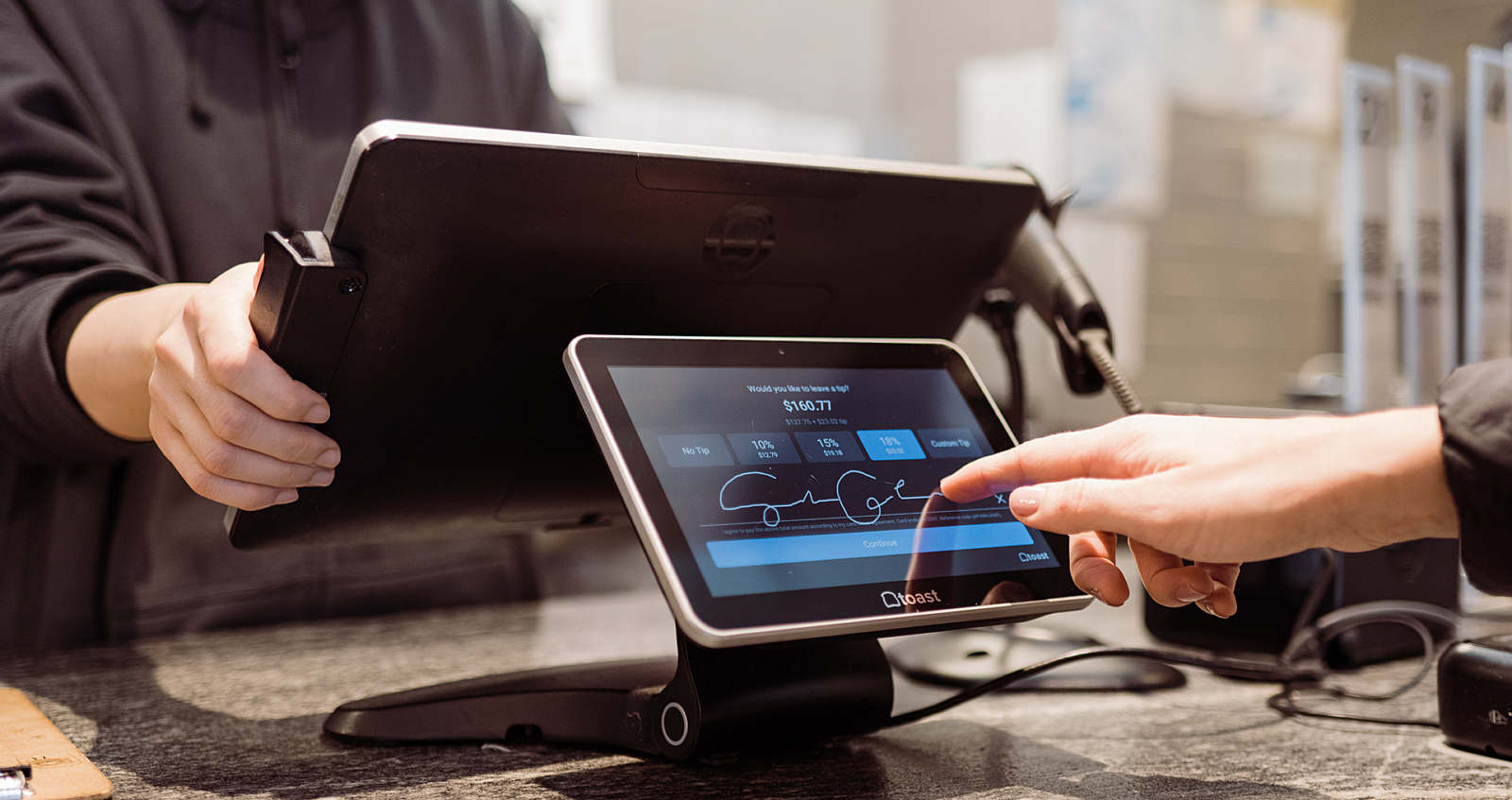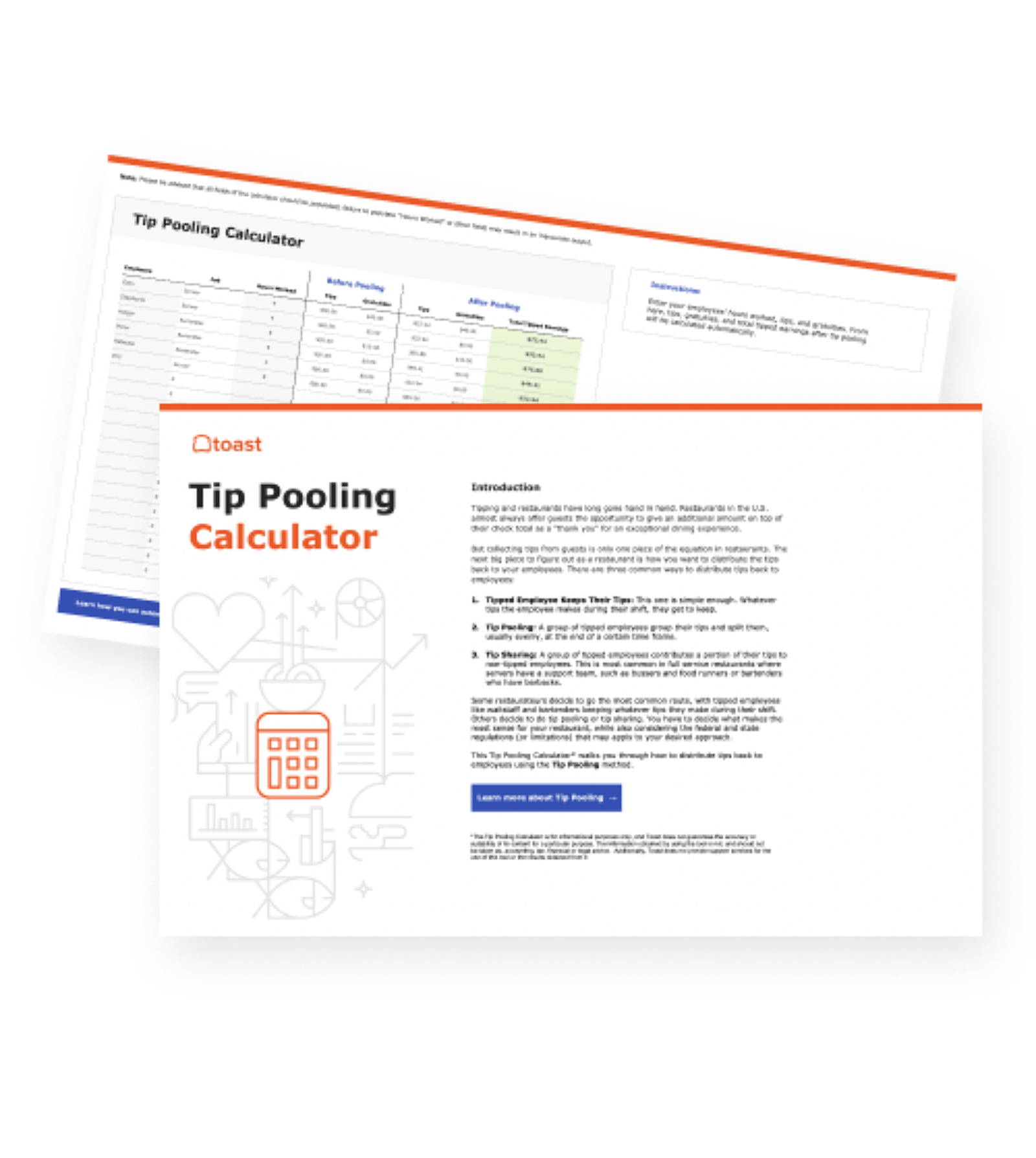
How Restaurant Guests Really Feel About Tipping In America
Learn how guests feel about the current state of tipping with this data-filled article.

Tessa ZuluagaAuthor


Tip Pooling Calculator
Use the Tip Pooling Calculator to learn how to distribute tips back to your restaurant’s employees using the tip pooling method.
Get free downloadTipping has become a hot topic in America. Even season 3 of Hulu’s hit restaurant show, “The Bear” recently referenced how controversial the practice can be. For most servers, tips are a lifeline. For many diners, they've become an increasing burden. Our data navigates the complex emotions and economics caught between these two realities.
To better understand how restaurant guests feel about the current state of the restaurant industry, trends, and expectations, Toast polled 1,571 U.S.-based restaurant guests over the age of 18 from February 14, 2024, to February 21, 2024, who have dined in, ordered takeout, or ordered delivery in the previous three months. Insights from this survey are directional and should not be interpreted as precise.
In this data-filled article, we'll explore the current tipping landscape in 2024, answering questions like:
How do guests feel about leaving a tip in different situations?
How do guests feel about tipping frequency?
What influences guests' decision to NOT leave a tip?
What are the current tip averages for applicable restaurants on the Toast platform?
Restaurant Survey Template
Use this template to ask your guests about their experiences in your restaurant. These survey questions will give you the data you need to make informed changes and improve the overall dining experience.

The state of American tipping culture
Has tipflation gotten out of control? Tipflation is a jargon word that combines “tip” and “inflation” — alluding to businesses asking for higher tip percentages than previously, as well as more businesses asking for tips in general. Increases in suggested tipping amounts on digital screens may be souring restaurant tipping percentages and contributing to tipflation.
Let’s dive into the data and see how restaurant goers are feeling about tipping in 2024.
When Americans are willing to tip
Toast asked: How do you feel about leaving a tip in each of the following situations?
At the heart of the data lies a clear preference for traditional service at sit-down restaurants. Approximately 79% of respondents say they are willing to tip a server who visits their table. This stat highlights the enduring value of face-to-face interactions and attentive customer service. Overall, guests are more willing to leave gratuity when the service is greater. Roughly 50% of guests are willing to tip for delivery when the order is placed online, 49% when the order is placed over the phone, and 43% when they order on a third-party app.
As the level of service declines, guests are less likely to tip. Only 26% of guests are willing to tip if they place their order on a third-party app but pick it up themselves, 23% of guests are willing to tip if they order from a QR code or via a restaurant’s website at the table, and 20% are willing to tip if they call the restaurant and pick up their food themselves.
This decline is consistent for quick-service models as only 17% of restaurant guests are willing to tip if they place their order at a counter and pick up their order themselves, 12% are willing to tip at a drive-thru, and 11% are willing to tip at a self-checkout kiosk.
This data reflects the importance of human interaction in the service industry. As restaurants increasingly adopt technology to streamline operations, they must carefully balance efficiency with the personal touch that customers clearly value. The data suggests that while convenience may be important, it doesn't necessarily translate to increased willingness to tip.
How Americans feel about tip option frequency
Toast asked: Thinking about now compared to 6 months ago, to what extent do you agree or disagree with the following statements about tipping at restaurants or other establishments that serve food?
Picture this: You're grabbing a quick beverage at a coffee shop, and suddenly you're faced with a digital tip jar. Sound familiar? More than half, 52% of respondents say they see tip requests pop up more often than just six months ago.
It's not just about how often guests are asked to tip service workers; 48% of respondents feel they’re being asked to leave bigger tips, too. Because of this tip amount suggestion increase, 29% of guests are getting more comfortable saying "no" to tipping. In fact, 29% of respondents also say they're skipping the tip more often.
We’re seeing more tip jars and bigger asks. However, some guests are pushing back, keeping their wallets closed. To learn about tipping etiquette and if you need to tip your barista at all, check out this article.
When guests are NOT willing to tip
Toast asked: Below are some reasons that could influence your decision to NOT leave a tip in a particular situation (assuming the establishment accepts tips). (Respondents were asked to rank their top 5)
You're picking up a pizza. Do you tip? 53% of respondents believe there’s no reason to tip if it’s a pickup order, and 49% believe they don’t need to tip if the order has an added fee or charge. Want to learn more about service charges and tips, and how each of them plays a role in the restaurant industry today? Check out this article.
Now, imagine ordering from a touch screen. Approximately 40% of respondents believe they don’t need to tip when ordering via kiosk. This is expected, as the customers are doing the work themselves instead of receiving good service from the waitstaff. This is appropriate in most cases, as kiosks are typically found in fast food and quick-service restaurants, where tipping isn’t typically expected.
Here’s an important stat for restaurants: 31% of respondents won't tip if they're not sure where the money's going. Tips are for the workers — not the business. There are laws in place to protect tipped-wage workers, who are typically paid a lower hourly wage than non-tipped workers, depending on the city and state.
In the United States, the federal minimum wage for tipped workers is currently $2.13 per hour, as compared to the standard minimum wage of $7.25 per hour for non-tipped workers. This is why communication with your restaurant guests is so important. By clearly communicating where the tips are going, why tipping is allowed, and whether or not it's encouraged, restaurants can help customers make informed decisions about how they want to show their appreciation for excellent service.
Roughly 27% of respondents believe they don’t need to tip if they haven’t been asked. Some restaurants may choose to adopt a no-tipping policy, in which service charges are added or included in the menu prices. However, others may still allow for tipping. Regardless of the policy, it's important for restaurants to clearly communicate whether or not tipping is encouraged.
Thankfully for tipped employees, it seems most big spenders are still big tippers. Only 20% of respondents believe they don’t need to tip if the dollar value of the order is too high. If guests are choosing to dine at a sit-down restaurant, the tip should be included in their budget.
Toast tipping data from the Q1 2024 Restaurant Trends Report
We also took a look at data from applicable full-service restaurants on the Toast platform where a tip was added to the order via a card or digital payment from January 1, 2022, to March 31, 2024. Here’s what we found.
Overall, tips remained generally steady in Q1 2024 compared to Q4 2023, which is good news for restaurant employees. In Q1 2024, 75% of FSR guests and 49% of QSR guests chose to tip with a card or digital payment. Total tips averaged 18.9% in Q1 2024, the same as Q4 2023. Full-service restaurant tips also remained flat at 19.4%, as did quick-service restaurant tips, which averaged 16% in Q1 2024.
Total average tips and tips at full-service restaurants have remained flat since Q2 2023. Quick-service restaurant tips have remained relatively unchanged, hovering between 16.1% and 16% since Q2 2023.
So how do individual states tip? In Q1 2024, Delaware was the most generous overall, with an average total tipping percentage of 22.1%. The state also has the highest tips for full-service restaurants, tipping an average of 22.5%, and quick-service restaurants, averaging 19.1%. A round of applause for Delaware!
Overall, California tips the least of all states, especially for full-service restaurants, where the average tip was only 17.9%. However, the state that tips the least generously at quick-service restaurants is New Jersey, with an average tip percentage of 13.8% in Q1 2024.
American tipping culture wrapped
Guests are still willing to tip at traditional sit-down restaurants. They value personal interaction and are less inclined to tip for more automated or self-service experiences. Although these options are convenient, they don’t require gratuity. Despite concerns about tipflation, Toast's platform data shows that tipping percentages have remained relatively stable over the past year. They’re not skyrocketing up or down.
As the industry continues to adapt to changing consumer preferences and technological advancements, clear communication about tipping policies and practices will be crucial for both restaurants and diners. Ultimately, the future of tipping in the USA will likely be shaped by an ongoing negotiation between service value, customer expectations, and economic realities. In the meantime, don’t forget to tip your servers and bartenders — happy dining!
Methodology
1To better understand how restaurant guests feel about the current state of the restaurant industry, trends, and expectations, Toast polled 1,571 U.S.-based restaurant guests over the age of 18 from February 14, 2024, to February 21, 2024 who have dined in, ordered takeout, or ordered delivery in the previous three months. Respondents were not made aware that Toast was fielding the study. Panel providers granted incentives to restaurant respondents for participation. Using a standard margin of error calculation at a confidence interval of 95%, the margin of error on average is +/- 2%.
2Data from applicable full-service restaurants on the Toast platform where a tip was added to the order via a card or digital payment from January 1, 2022, to March 31, 2024. Cash tips are not included in the analysis.
Is this article helpful?
DISCLAIMER: This information is provided for general informational purposes only, and publication does not constitute an endorsement. Toast does not warrant the accuracy or completeness of any information, text, graphics, links, or other items contained within this content. Toast does not guarantee you will achieve any specific results if you follow any advice herein. It may be advisable for you to consult with a professional such as a lawyer, accountant, or business advisor for advice specific to your situation.
Subscribe to On the Line
Sign up to get industry intel, advice, tools, and honest takes from real people tackling their restaurants’ greatest challenges.
